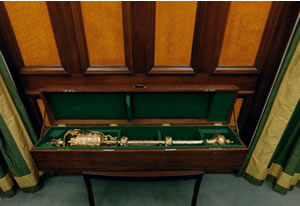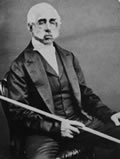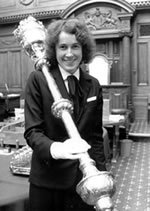Staff and spectators: Ceremonial positions
The mace in the Speaker's office. View as panorama.
New Zealand's early politicians wanted Parliament to adopt and adapt the traditions of the British Parliament. In doing this, it was believed that New Zealand's Parliament would be invested with great dignity. Accordingly, a number of the ceremonial positions that are to be found in the British Parliament also appear in New Zealand.
Serjeant-at-Arms
The Serjeant-at-Arms (or Sergeant-at-Arms, until the 1950s) carries the mace or the symbol of the Speaker's authority, for the official opening of Parliament, and also at the opening of every sitting when she or he leads the Speaker into the House and announces the Speaker's presence.
The Serjeant initially carried a white 'wand' instead of a mace, and wore a black suit with white gloves and a white waistcoat. The first Sergeant was Philip Deck, a former sea captain, who was appointed in 1854, although not in time for the inaugural sitting of Parliament in May that year.
The tradition of the Serjeant dates back many centuries to when 'Sergeants-at-Arms' were bodyguards to the King or Queen. The mace, carried by the Serjeant, is a stylised version of a large weapon shaped like a club. Traces of the bodyguard function can still be seen today. The Serjeant may be required to escort unruly MPs ― and in the early days, some drunk ones ― out of the House. On these rare occasions the role becomes more than symbolic and moves to one of enforcing the Speaker's authority.
There have been other tasks, too. In the nineteenth century, the Sergeant made sure that the House's snuff box was filled, for MPs were not allowed to smoke in the chamber. In 1877, the Sergeant placed George Jones, a newspaper reporter ― and future MP ― under a mild form of 'House arrest' after he was called to the bar of the House following accusations in his paper about one MP. The 'arrest' consisted of being held in a room, where he was liberally supplied with refreshments and cheroots (a type of cigar) and allowed to play his violin, while the House debated what action to take against him.
Lock the Doors!
Just a week or so after he took up his duties in August 1854, Sergeant-at Arms Deck had to assert his position during an unruly debate. Opposition members who did not want to vote on an issue tried to flee the House in order to remove the quorum of members necessary for a vote to be taken. Someone shouted 'Lock the doors!', which Deck did, thinking that the Speaker had given him an order. As MPs chased each other around the House, clambered into the public gallery and shouted about a quorum, the Sergeant threatened to take them into custody.
The Mace
The ultimate symbol of Parliament's authority is the mace. Today's mace, obtained in 1909, is modelled on the one used in the House of Commons. It is about 1.3 metres long, is made of sterling silver gilt with 18-carat gold, and is decorated with fleur de lys, and roses, harps and thistles that symbolise the union of the British peoples. The Southern Cross and 'N.Z.' are engraved on a panel. The mace is kept in the Speaker's office when not in use; when the House is sitting, it is on the Table of the chamber, and under the Table when the House is in Committee.
New Zealand's Parliament got its first mace in 1866 — 12 years after the first sitting. This did not stop the compilers of Parliament's records from writing it into the records from 1855 as if it did exist. This mace was a gift from a retired Speaker, Charles Clifford, because the Premier was reluctant to go to the expense of purchasing one. It was destroyed by fire in 1907, and for two years, Parliament made do with a temporary mace made of polished puriri wood with gilt decorations.
Black Rod
The Legislative Council had its equivalent of the Sergeant-at-Arms, known as the Gentleman Usher of the Black Rod, or Black Rod for short. The rod itself was initially just a plain black wooden staff, a little like a billiard cue, but that used since 1931 is more ornate. Arthur Bothamley became the first Black Rod in 1914, although he had been acting in this role since 1892. Black Rod became a ceremonial position once the Legislative Council was abolished at the end of 1950, and today, Black Rod plays an important part in the official opening of Parliament. In 1993, Bill Nathan became the first Maori Black Rod.
Next: Watching Parliament >



